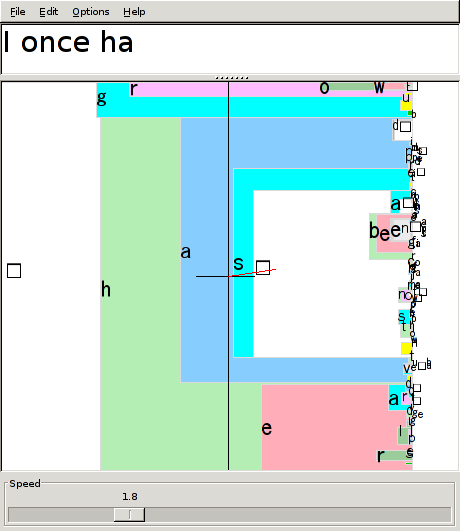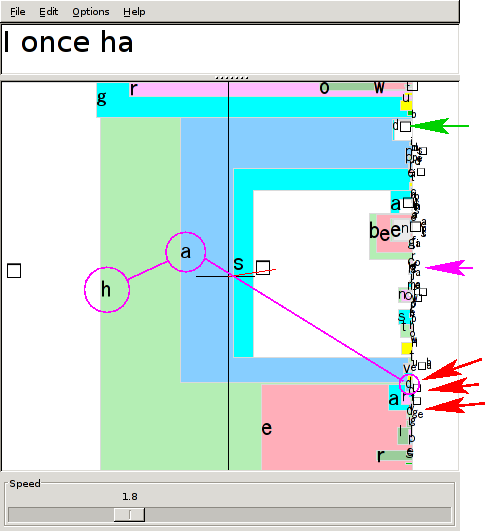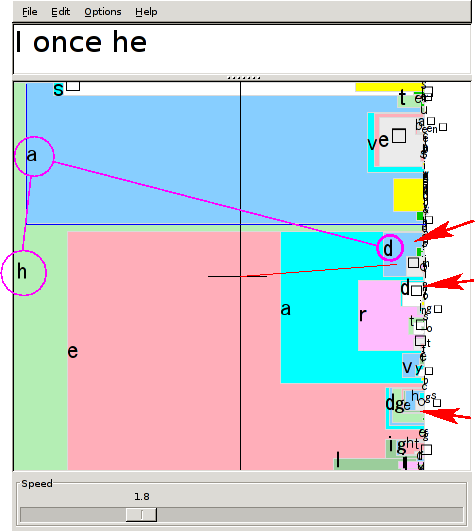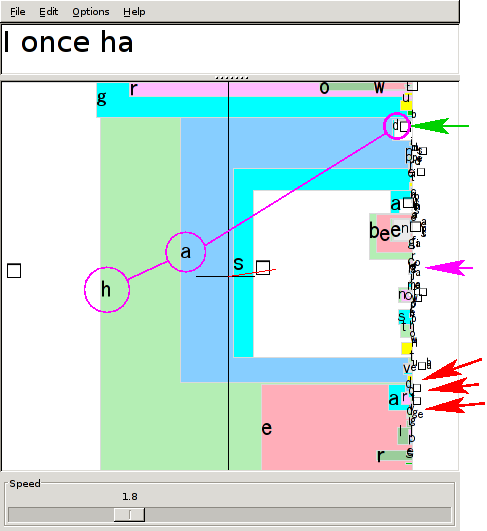|
|
 |

Tips for Novices ... continued
Common errors.
Often, a beginner who is trying to find a particular
letter will drive the display forwards fast while hunting
for the letter. The rule of the road for Dasher users
is just like that for car-drivers: don't drive forwards
until you have identified where you want to go!
So, after you have found the first letter of your sentence,
and zoomed towards it, please SLOW DOWN and don't proceed
any further into this first letter's square until you
have figured out where you should be steering towards.
Your next letter is there, immediately inside the
first square you have entered. The letters are ordered
alphabetically. If you can't see your letter, figure out where it
must be on the basis of the letters you can see. Then point to
the right place and enter the second letter's square.

| | Figure 1: writing 'I once had a whim'
|
Here is an example.
Imagine you want to write 'I once had a whim'.
You write 'I once ha...' and the Dasher display
looks like figure 1.
You want to write 'had'. What should you do?
There are lots of letter ds on the screen,
and all of them are rather small.

| | Figure 2: some alternative letter ds, with
a beginner's error highlighted.
|
The five arrows in figure 2 show some of these
ds. The purple arrow points
to a d that we can't see yet, but
we know it must be there because we can see 'a', 'b', and 'c'
above it.
A common beginner's mistake is to keep rushing forward and spot any
of these letter ds, and zoom into it.
For example, figure 3 shows what happens if the user
zooms towards the d marked by the top red arrow of figure 2.

| | Figure 3: selecting the wrong letter d.
|
If you go in this d, you are writing 'I once head...'.
The other ds labelled by red arrows correspond to
writing 'I once heard...'
and
'I once hedge...'.
It is crucial to understand that there is only one correct d,
namely the d that is immediately inside the
blue box corresponding to letter `a' in the sequence 'I once ha'.
That blue box is highlighted in figure 4.

| | Figure 4: the correct letter d is the one marked by
the green arrow. This example illustrates the rule "always keep going inside
the box that you want" -- in this case, the blue box
associated with the letter a of the word 'had'.
|
If you ever leave that blue box (as we did in figure 3)
then we lose the letter 'a'.
Yet more tips for beginners...
|
The Dasher project is supported by the Gatsby Foundation and by the European Commission in the context of the AEGIS project - open Accessibility Everywhere: Groundwork, Infrastructure, Standards) |  |
Site last modified Sat Mar 19 12:11:40 UTC 2016
|
|




